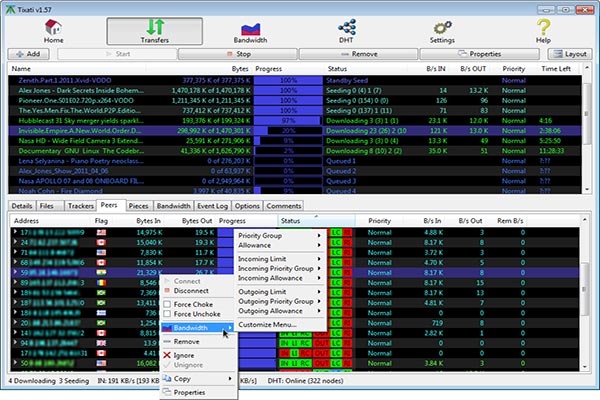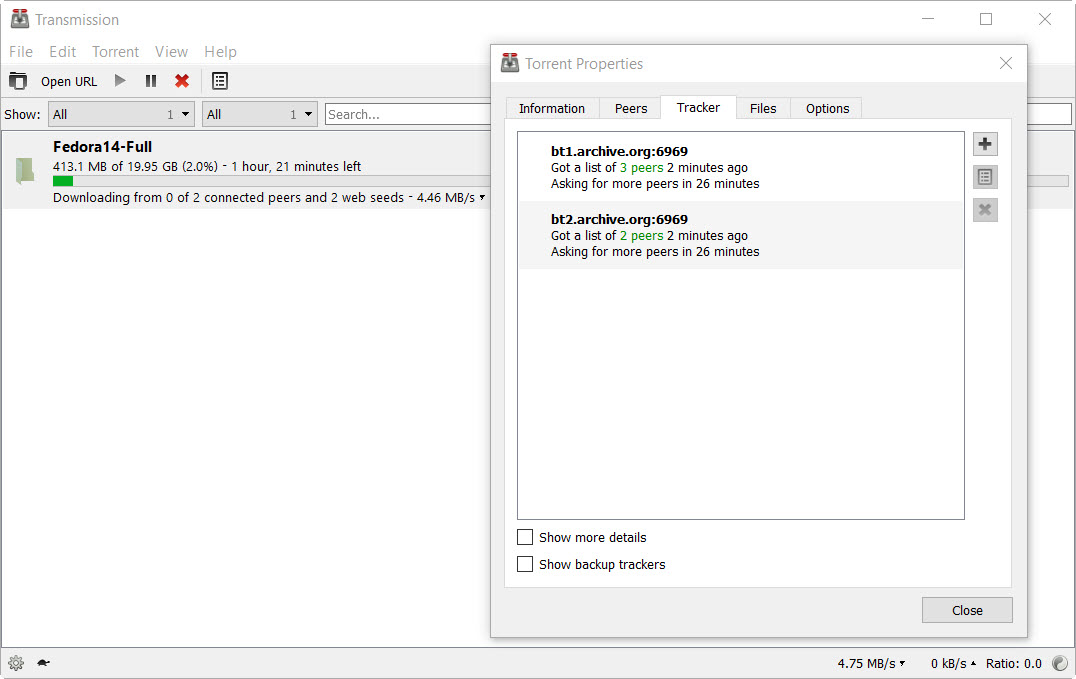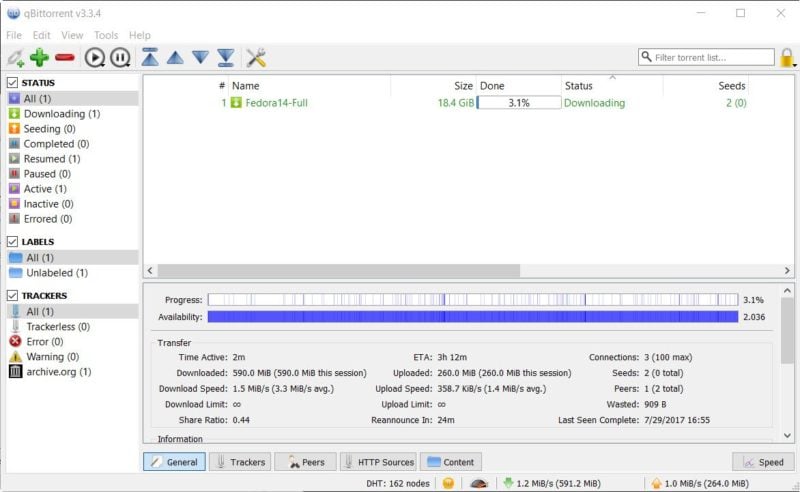Sync Hacks is a column dedicated to exploring new applications for BitTorrent Sync, as built by users like you. BitTorrent Sync is a free, unlimited, secure file-syncing app. (And now, it’s 2X faster.) If you’ve got an epic Sync idea, use-case or how-to, shoot us an email at sync[at]bittorrent.com.
It is the most popular P2P client available for Windows operating system.

In this week’s Sync Hacks, Torben Stallknecht walks us through how to set up BitTorrent Sync on a Synology Network Attached Storage (NAS) to access large files from anywhere.
This post is adapted from Torben’s original tutorial found here.
From Torben:
Before you start
- Sudo mkdir /mnt/torrents sudo mount /dev/sda1 /mnt/torrents. To check if it worked, use the following command and you should see the mount point at the bottom. We want this hard drive to be mounted everytime we reboot. So we need to do the following. Sudo nano /etc/fstab. Create a new line under the last /dev and write.
- NAS4Free / XigmaNAS. Originally the XigmaNAS was known as NAS4Free but in 2018 it renamed.
- Author Topic: Add-on torrent clients for D-Link NAS (Read 21661 times) vtverdohleb. Level 5 Member; Posts: 712; Add-on torrent clients for D-Link NAS.
- Web Torrent is, by far, the easiest torrent client I have used. It is a great torrent client alternative for users who want to keep themselves away from confusing features. All you need to do is.
1. In order to setup Bittorent Sync on your NAS, please make sure that your NAS has a supported CPU. To find out which CPU your NAS has, look here.
2. This guide assumes the following reparation and knowledge: This includes router setup and firewall configuration. You will need port 8888 to be open and forwarded to your NAS.
Setting up a user
Because we do not wish to run the Sync service as root, we will be setting up a user.

Adding the user
This portion should be something you know about, so I have not gone into detail about this. As long as you just create a standard user, the rest of my guide should fit your needs.
Enabling user to login to SSH/Terminal
The default behavior for new users on the Synology NAS is that they are not allowed to login through SSH. This is easily resolved by altering the /etc/passwd file.
To do this-
1. Login to you NAS using SSH
2. Perform the command: vi /etc/passwd Find the line with your BitTorrent Sync user listed.
3. Here, change the last part of the line, where it says: /sbin/nologin this needs to say /bin/sh
4. Now, you do not need to logout just yet, to get started.
5. In order to get started with the btsync user, simply issue the command: su – btsync
Setting up BitTorrent Sync

By default you will be sent to the home directory of the BitTorrent Sync user. We want this.
1. Now we are going to create some folders. I use two folders. A bin folder and a conf folder.
2. Next, get a hold of the latest build that fits your needs. For my DS-1513+, it is build 1.2.82. We will aquire the build using wget. For the current build, the url is http://download-lb.utorrent.com/endpoint/btsync/os/linux-glibc23-x64/track/stable/btsync_glibc23_x64.tar.gz
Please notice, that I need to get the glibc23 version, as Synology ships their OS with this old version of GLIBC for the DS-1513+. To check which version of GLIBC your NAS has, issue the following command:

It will give you something along the lines of: (BOLD text indicating version of GLIBC) GNU C
If the version is 2.4 or above, you are free to get the full build:
http://download-lb.utorrent.com/endpoint/btsync/os/linux-glibc23-x64/track/stable/btsync_x64.tar.gz
3. Get the file into the bin folder
In order to get the file, issue the command
4. Once we have the file downloaded, we want to extract it.
Two files are then extracted.

5. Now we want to get the configuration, so that we get the system set up as we want. In order to generate the default configuration file, issue the command.
Change the sync.conf fil to fit your needs. The main things you want to change, is the device_name and the credentials under webui. Also, you might want to change the storage_path. For my setup, I have simply commented the line, as the app then automatically adds the folder with the auxiliary files, in the bin folder.
6. Once this is done, it is time to fire up the app.
Move into the bin folder, and issue the command:
7. Now, in your browser, enter
And enter the credentials you added to the sync.conf file
You are ready to start setting up shared folders on your NAS.
Torben Stallknecht is a Danish “hobby” programmer, mainly working with C#.NET, PHP and most of the things around it. (Various SQL-servers etc.) You can reach him by email at torben@hamdenkloge.dk
FreeNAS is a free NAS server that turns a regular PC into a network storage server. The software is based on FreeBSD, Python, and supports tools for CIFS (samba), FTP, NFS protocols, Software RAID (0, 1, 5) and web interfaces.
Users can access the storage server through Windows, Mac, FTP, SSH and Network File System (NFS); FreeNAS can be installed on the hard disk or removable media USB Flash Disk, occupying less than 16MB. The FreeNAS server has a promising future; its development work is very active. It’s a great way to set up a simple network storage server, eliminating the hassle of installing a full set of FreeBSD. Moreover, FreeNAS also has the function of monitoring the network.
The important point is that Freenas does not support the same hard disk for system files and storage. The system file uses a single device. The device can be a USB memory card, a USB flash drive, or a separate hard disk while the storage will be on another disk attached to it.
FreeNAS also offers commercial storage servers along with FreeNAS for the enterprises called TrueNAS. However, for open source software lovers, their community version is enough with all unlock features those are of enterprise grid. But the story doesn’t end here, yes, the FreeNAS for creating DIY personal or commercial storage is an impeccable software, nevertheless, there are a handful of FreeNAS alternatives projects available online. If you are looking for some are those…
Contents
- 1 Freenas Alternatives for DIY NAS projects 2019
Freenas Alternatives for DIY NAS projects 2019
1. NAS4Free / XigmaNAS
Originally the XigmaNAS was known as NAS4Free but in 2018 it renamed and also one of the best open-source NAS projects alternative to FreeNAS. XingmaNAS based on original FreeNAS code. It is an embedded network storage system based on FreeBSD open-source free Windows, Mac and UNIX-like systems.
NAS4Free being a FreeNAS alternative can be installed on almost any hardware platform to share computer data storage over a network and store it in a computer network. NAS’s “Network Attached Storage” and “4” for free and open-source, NAS4Free is the easiest and fastest way to create a centralized and easy to get a server for all types of data!
It is the easiest and fastest way to create a centralized and easily accessible server for all types of data. The system has OpenZFS, RAID (0, 1, 5), Disk encryption (Uses cryptographic accelerator card if present), BitTorrent client, phpVirtualBox and noVNC (HTML5/WebSocket VNC client) for VM management; Internal file manager, Link aggregation, Wake On Lan; Real-time network and CPU statistics, Partition: MBR and GPT, ZFS, SMART/email reporting, several different protocols/services and more… All of this can be easily managed through a configurable web interface.
2. Rockstor NAS & Cloud
In this list of FreeNAS alternatives, Rockstor is also free and open-source software that available in three solutions: Personal Cloud Server, SMB Cloud Server and Traditional NAS server.
The Personal cloud server is for those users want a public cloud-like a personal cloud on their own hardware to access the data from anywhere using the internet. It can be accessed from a laptop, desktop, mobile devices or any device running with the browser. It can also support to move data between the public cloud and your devices.
Rockstor SMB Cloud Server meant for Small and Midsize Business those have demanded of several hundred Terabytes of storage. This allows them to reduce the cost that they spend on public cloud storage, moreover, it can integrate with public cloud storage to provide a hybrid kind of cloud model where the organizations can scale storage needs with a low incremental cost.
Rockstor Traditional NAS Server as its name suggests the conventional approach of Network access storage. This is the solution suggested for those need a robust solution with bells and whistles. Built on Linux, it needs less space and RAM, needless to say, the full potential of BTRFS as a NAS file-system.
Best Torrent Client For Speed
Just like the FreeNAS, the user simply can manage all of them using the Rockstor’s Web-User Interface.
Features it provides are Linux based with BTRFS; Bitrot protection, checksums, compression and other advanced filesystem features; File sharing from Linux, Windows, macOS and Mobile; File backup with Rsync, Apple Time Machine and Windows Backup; Disaster recovery; Fast and online vertical capacity scaling; Resource monitoring; REST API; Snapshots, cloning, Simple GUI installer, Apps (Rock-add-ons) for media streaming, backups, cloud storage and more.
Download:Rockstor FreeNAS Alternative
3. OpenMediaVault
OpenMediaVault is another open-source FreeNAS alternative network-attached storage ( NAS ) solution based on Debian Linux.
OpenMediaVault includes numerous services such as SSH, (S)FTP, SMB/CIFS, DAAP Media Server, RSync, BitTorrent Client and more. It also has a modular design framework features that can be enhanced with plug-ins.
FreeNAS alternative OpenMediaVault initially was developed to provide NAS facility to home environments or small home offices but later it proliferated and expanded its reach to further verticals too. It is just like FreeNAS available in ISO file which can be easily installed top operated without much deeper knowledge to install and manage Network Attached Storage ( NAS ).
Key features Debian Linux, Web-based system management, Simple system upgrade via Debian package, User Management, Scheduled Tasks, Multi-language support, Service announcement based on DNS-SD (Apple’s protocol), Plugin system, Link aggregation, Wake On Lan, IPv6 support, Email notifications and File sharing.
Few plugin names of OpenMediaVault are ClamAV – Antivirus, Forked-Daapd – DAAP media server, ldap – User authentication via LDAP, lvm2 – LVM management, netatalk – AFP file sharing, nut – Network UPS Tools
route – Additional route management, shairport – AirPlay/RAOP receiver, USB backup – USB auto backup and more…
Download – OpenMediavault
4. unRAID
unRAID is one of the best paid FreeNAS alternatives which comes with a wide range of features and also easy to use. The minimum hardware system requirements of the unRaid are 64-bit CPU, 1.0 GHz or better, minimum 2GB of RAM; Linux hardware driver support for storage, Ethernet, and USB controllers and 2 hard disk drives. It is basically a consumer-oriented NAS server operating system designed to scale with a system’s hardware.
It provides the graphical user interface for different operations, supported file systems are XFS (default), BTRFS, GUI and email alerts; SMB, NFS, AFP; FTP, Rsync (CLI), SSH (CLI); S.M.A.R.T., UPS (APC only); KVM, Qemu and more… The user can experience it by downloading the unRaid free trial version before investing money into it.
5. Nexenta Community Edition
Another enterprise-class alternative to FreeNAS that also has a premium version. The difference between the paid Nexenta and community Nexenta edition is the 10TB storage limit that imposed to the free one. Yes, if you are a home user you can try the Nexenta community edition because apart from 10TB restriction rest of all features are the same as the paid ones.
Moreover, for standard home-office users, the 10TB is enough. Being a paid supported project getting latest updates is for sure and also it is not going to abandon in the near future.
The features of this alternative project to FreeNAS are Integrated & Optimized for VMware; Enterprise-grade storage services, REST API, Backup & Archive; Enterprise File Services; Integrated & optimized for VMware, Microsoft, & OpenStack infrastructure environments and more. It also includes NexentaFusion to provide reporting, monitoring, analytics, and orchestration for your storage assets from a single page.
Download the Nexenta community edition.
6. EasyNAS
EasyNAS is a storage management system with a web management interface for home or small office use. It based on OpenSUSE and has BTRFS filesystem. The interface of the EasyNas looks very familiar and easily can be managed by anyone.
Download EasyNAS
Best Nas Software
Other Useful Alternatives